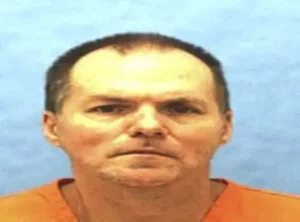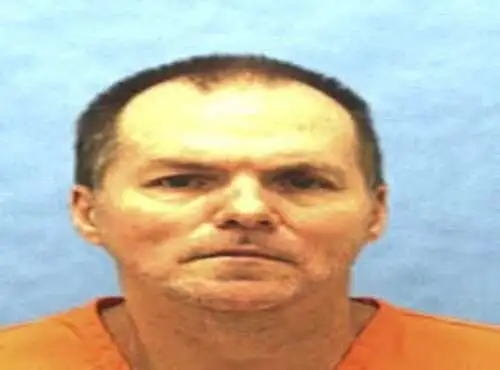Mark Asay was executed by the State of Florida for a racial murder
According to court documents Mark Asay would shoot and kill Robert Lee Booker and would comment on his race during the murder
That same year Mark Asay would also murder a Hispanic man Robert McDowell
Mark Asay would be arrested, convicted and sentenced to death
Mark Asay would be executed by lethal injection on August 24 2017 becoming the first White man in Florida history to be executed for killing a Black man
Mark Asay Photos

Mark Asay FAQ
When Was Mark Asay Executed
Mark Asay was executed on August 24 2017
Mark Asay Case
For the first time in 18 months, Florida carried out a death sentence, killing Mark James Asay as final punishment for two 1987 murders in Jacksonville and making Asay the first white man ever executed in the state for killing a black victim.
Asay was pronounced dead at 6:22 p.m. Thursday. He was 53.
The execution began at Florida State Prison after the U.S. Supreme Court, without comment, denied Asay’s final appeal. At 6:10 p.m., a curtain lifted between the death chamber and a room for witnesses. The lighting flickered, and the air-conditioning was turned off, making for an eerie quiet.
“Mr. Asay, do you have a final statement?” a guard asked.
“No, sir,” he replied. “I do not.”
“The preparation phase has ended,” the guard said. “The execution phase will begin.”
Outside, thunder rumbled.
Asay’s chest moved up and down, and then it stopped. The guard shook Asay’s shoulders, then stood back.
Eight minutes later, a doctor emerged.
The state executed Asay because a jury found him guilty of killing Robert Lee Booker and Robert McDowell minutes apart in Jacksonville’s Springfield neighborhood. The jury recommended he be put to death by a vote of 9 to 3. The U.S. Supreme Court later ruled that death sentencing system unconstitutional, and though the Florida Supreme Court now requires unanimous jury decisions, the new standard applies only to cases going back to 2002.
Asay’s attorneys said the best argument for stopping the execution would have been to say that 2002 is an arbitrary date, and because the death sentence vote wasn’t unanimous, he should be resentenced. Asay refused to let them make that argument, attorney Marty McClain said, instead asking them to argue he wasn’t guilty of murdering Booker, the black man.
When Asay was arrested, his arms bore white supremacist tattoos, and witnesses said he referred to one of the victims by the N-word.
Frank Booker, Robert Booker’s brother, said Thursday afternoon that “we’ve been waiting for this since 1987, and that’s a long time.
“I feel a lot of pressure and anxiety will be off me, and I’ll be able to continue in life, I think, a lot more peaceful because this was something that touched a lot of us really, really deep. I know he feels sorry now, but he should’ve thought about that in ’87 when he did what he did.
“He did it. All the evidence pointed that way.”
Asay’s brother and another friend who were with him the night of the killings testified that the three were drinking and looking for sex. While his brother was talking to Booker, Asay used racial slurs. He then shot Booker in the stomach and fled.
The men then hired McDowell, who was dressed as a woman and using the name Renee Torres, to perform oral sex, according to their testimony. Asay then shot and killed McDowell. One of the witnesses said Asay killed McDowell because he felt ripped off. A jailhouse informant later said Asay referred to McDowell using a derogatory word for gay men.
Asay admitted this week to News4Jax that he killed McDowell, who was white. The race of Asay’s victims matters because a racist motive can help prove a murder is cruel, calculated and premeditated, and worthy of execution.
The execution of Asay included the use of two drugs never before used in Florida: potassium acetate, which was used by accident in an Oklahoma execution in 2015, and etomidate, which had never been used anywhere for an execution. States that still carry out the death penalty have struggled to acquire the necessary drugs for lethal injection and have started changing their cocktails. Asay’s lawyers argued that the new injection mixture would violate his constitutional right to be free of cruel and unusual punishment.
On Thursday afternoon, a corrections official handed out packets about how the new injection process would work, but she wouldn’t answer questions about how the state chose the drugs.
Since Asay’s trial in 1988, Duval County has led the state in handing down death sentences, with Assistant State Attorney Bernie de la Rionda getting more death sentences than almost any prosecutor in the country. Asay’s execution was the first of de la Rionda’s death sentences to be carried out.
Asay’s death sentence came in the shadow of one of the most significant challenges to the death penalty in American history, when a defendant argued that the death penalty was inherently racist because it was applied to black defendants at a rate disproportionate to that of white defendants. Asay was sentenced to death a year later.
Asay argued he wasn’t guilty of killing Booker and that he wasn’t a white supremacist, saying he only got the tattoos to avoid being attacked in a Texas prison for a past offense. In his final interview this week, he told News4Jax that he has tried to cover up or burn the tattoos that he could reach on his body.
On Thursday, Asay awoke at 4:30 a.m., and for his final meal he asked for fried pork chops, fried ham, french fries, Coca-Cola and a swirl of vanilla ice cream. He met with his sister, sister-in-law and brother-in-law, then met with a spiritual adviser. A prison official described Asay as calm and collected.
No one from Asay’s family witnessed the execution, but Norman Smith, Asay’s spiritual adviser for the last year, did. Smith, who was the only black witness to the execution, said he had no doubt that Asay had believed in Jesus Christ and been changed. “In the months I’ve been counseling him, … I would have never known that this man was tagged as a racist.”
On Monday, Asay seemed to give up on his appeals, sending a handwritten motion to the court. “Petitioner has for nearly thirty years sought relief from the convictions and death sentences in this case. Petitioner submits that he is now satisfied that the desired relief is not available to him. Therefore, he now wishes to cease pursuing that relief and put an end to any further futile effort in that regard that serves only to delay the inevitable.”
